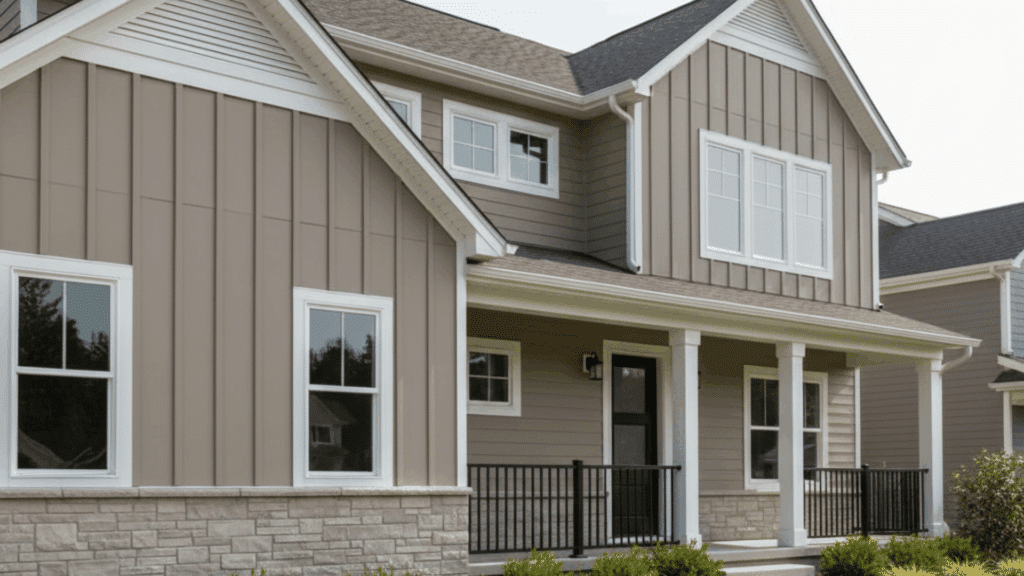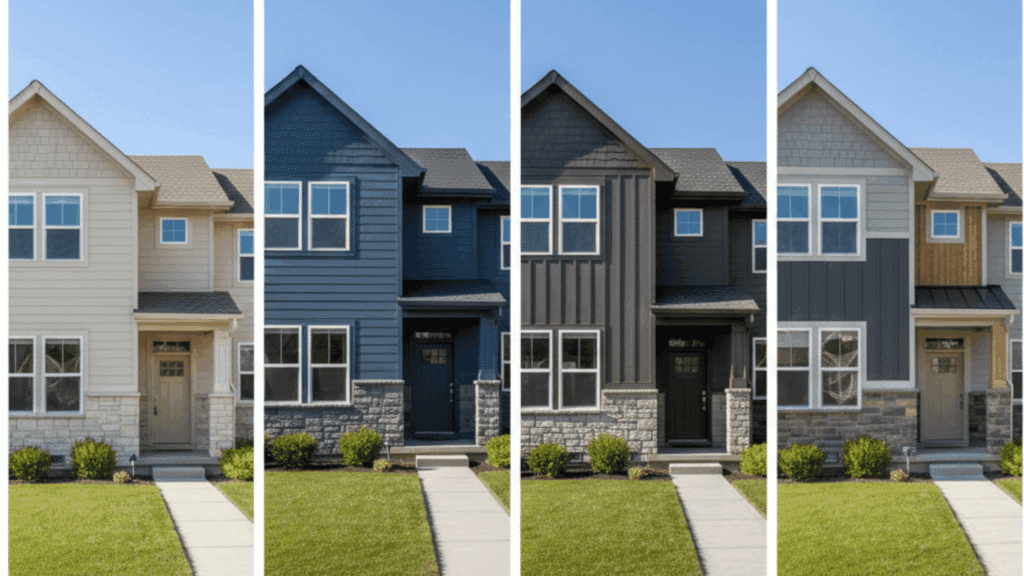Replacing your home’s siding represents one of the most significant exterior investments, which is why understanding how much new siding costs is crucial before starting your project.
If you’re dealing with damaged materials, outdated aesthetics, or simply want to boost curb appeal and energy efficiency, siding replacement costs can vary dramatically based on numerous factors.
The answer depends on your home’s size, material choices, labor rates in your region, and hidden factors like wall preparation and trim work.
This blog will break down real-world pricing, share homeowner experiences, and provide practical strategies for managing these substantial expenses effectively.
Importance of Siding in Your Home
Siding matters because it acts as your home’s first line of defense against weather, moisture, and pests.
Quality siding helps prevent rain, snow, and humidity from seeping into the structure, reducing the risk of mold, rot, and costly repairs.
It also improves energy efficiency by adding an extra layer of insulation that keeps indoor temperatures steadier year-round.
Beyond protection, siding plays a major role in curb appeal. Fresh, well-maintained siding can completely transform a home’s appearance and significantly boost its resale value.
Different materials offer varying levels of durability, maintenance needs, and longevity, but all contribute to the overall performance of the exterior.
How Much Does Home Siding Replacement Cost?

The cost of replacing home siding typically ranges from $10,000 to $30,000 for an average-sized home. But the final price depends heavily on the material you choose, the size and layout of your home, and regional labor rates.
Most homeowners pay $4 to $14 per square foot installed, with vinyl on the lower end and materials like fiber cement, wood, metal, or stone veneer landing much higher.
Multi-story homes, complex architectural details, and the need to remove old siding can all increase labor time and raise your overall cost.
Additional upgrades, such as new insulation, trim, or house wrap, also add to the budget.
Overall, siding replacement is a major investment but one that improves curb appeal, boosts energy efficiency, and increases long-term home value.
How to Calculate the Cost of Siding Your Home Exterior?
Calculating the cost of siding begins with measuring the length and height of each wall, subtracting windows and doors, and then multiplying to get the siding area.
Once you have the total square footage, select your siding material: vinyl, fiber cement, wood, metal, or engineered wood, as each has its own price range per square foot.
Don’t forget extra expenses such as house wrap, insulation, trim, fasteners, and old siding removal.
Finally, add a 10–15% buffer for waste and unexpected changes. By combining material, labor, and additional components, you’ll get a realistic total for your siding project.
Total Siding Cost = Material Cost + Labor Cost + Additional Expenses
Factors That Affect Your Siding Replacement Costs
Several key factors influence how much your siding replacement will cost, from the materials you choose to the size and design of your home.
1. Home Size & Square Footage
Larger homes require more materials and labor hours, directly increasing overall costs.
Contractors typically charge per square foot, so a 2,000-square-foot home costs significantly less than a 3,500-square-foot property. Accurate measurements ensure proper budgeting.
2. Siding Material Choice
Material selection dramatically impacts pricing, ranging from affordable vinyl ($3-$12 per square foot) to premium options like fiber cement, wood, or stone veneer.
Each material offers different durability, maintenance requirements, and aesthetic appeal, influencing both upfront and long-term costs.
3. Labor Rates
Installation costs vary by region, contractor experience, and local demand. Urban areas typically charge higher labor rates than rural locations.
Skilled installers command premium pricing but deliver superior workmanship, proper installation techniques, and warranty protection that justify the investment.
4. Removal of Old Siding
Stripping existing siding adds disposal fees and labor time to your project. Older homes may have multiple siding layers requiring removal.
Hazardous materials like asbestos siding demand specialized removal procedures and certified professionals, substantially increasing removal costs and project timelines.
5. Home Design & Complexity
Architectural features like multiple stories, intricate trim work, dormers, and bay windows increase installation difficulty and time.
Complex designs require additional cutting, fitting, and customization. Simple ranch-style homes cost less to side than Victorian or multi-level homes with elaborate detailing.
6. Repairs & Prep Work
Underlying structural damage, rot, or water infiltration must be addressed before new siding installation. Repairing sheathing, framing, or moisture damage adds unexpected costs.
Thorough inspections reveal hidden problems that, when corrected, ensure your new siding performs optimally and lasts longer.
7. Insulation & House Wrap
Adding insulated siding or upgraded moisture barriers improves energy efficiency but increases material costs. Quality house wrap protects against water intrusion while allowing vapor escape.
These investments reduce heating and cooling expenses over time, offering substantial long-term savings despite higher initial expenditures.
8. Permit Fees
Most municipalities require building permits for siding replacement projects, costing between $100-$500, depending on location and project scope.
Permit fees cover inspection, ensuring work meets local building codes and safety standards. Skipping permits risks fines, insurance complications, and resale difficulties
Home Siding Cost by Material Type
To understand how different siding materials impact your budget, here’s a clear breakdown of estimated costs by material type.
| Siding Material | Material Cost per sq. ft. | Installed Cost per sq. ft. | Average Total Cost for a 2,000 sq. ft. Home |
|---|---|---|---|
| Vinyl Siding | $1–$4 | $4–$10 | $8,000–$20,000 |
| Fiber Cement (Hardie) | $2–$6 | $6–$13 | $12,000–$26,000 |
| Engineered Wood | $2–$5 | $5–$12 | $10,000–$24,000 |
| Natural Wood (Cedar, Pine) | $3–$8 | $7–$16 | $14,000–$32,000 |
| Metal (Aluminum/Steel) | $3–$7 | $6–$14 | $12,000–$28,000 |
| Stucco | $4–$9 | $8–$18 | $16,000–$36,000 |
| Brick Veneer | $8–$15 | $12–$28 | $24,000–$56,000 |
| Stone Veneer | $10–$20 | $20–$45 | $40,000–$90,000 |
How Much Does New Siding Cost in Different Regions
The cost to install new siding varies significantly by region due to wage rates, material availability, climate requirements, and building codes.
In the Northeast and West Coast, where labor and regulation are more expensive, homeowners can pay 15 – 40 % more than the national average.
In contrast, many Southern and Midwestern areas enjoy lower labor and material costs, making siding replacements more affordable.
For example, the national average installed cost for a typical siding job in 2025 falls around $10,000 – $25,000 for a 2,000 sq ft home.
To budget accurately, homeowners should check local contractor bids and factor in regional premiums for extreme weather zones or specialty materials
Home Siding Cost by House Size
To help you estimate your siding budget more accurately, here’s a breakdown of average costs by home size.
| Home Size | Approx. Square Footage of Exterior Walls | Estimated Siding Cost (Installed) | Typical Price Range |
|---|---|---|---|
| Small Home | 1,000–1,500 sq. ft. | $6,000–$15,000 | $4–$10 per sq. ft. |
| Medium Home | 1,500–2,500 sq. ft. | $10,000–$25,000 | $4–$12 per sq. ft. |
| Large Home | 2,500–4,000 sq. ft. | $15,000–$40,000+ | $5–$14 per sq. ft. |
| Extra-Large Home | 4,000+ sq. ft. | $30,000–$60,000+ | $6–$15 per sq. ft. |
Community Perspectives That Matter
Real-world feedback shows how much siding prices can vary depending on region, materials, and project complexity.
One homeowner from New England noted that
“25Kish seems about the minimum anywhere for vinyl siding. I’m in New England and getting our 2 story done was 22K,” highlighting higher regional labor costs.
Another homeowner comparing fiber cement options shared,
“Cheapest quote I got for Hardieboard was about $12 sq/ft… the guys I would have used were closer to $18 sq/ft,” which ultimately led them to repaint instead.
Another user said
Even insulation choices affect pricing, with users asking whether contractors mean “1/4 spacer or 2in of rigid,” since thicker insulation essentially means rebuilding the home’s exterior envelope.
Conclusion
Understanding how much new siding costs empowers you to make confident decisions about this major home investment.
Remember that quality siding isn’t just about aesthetics; it’s an investment in your home’s protection, energy efficiency, and resale value.
If you choose budget-friendly vinyl or premium fiber cement, knowing how much does new siding cost in your specific market helps you budget realistically and avoid unpleasant surprises.
Compare pricing, warranties, and customer reviews to find the perfect balance between quality and affordability for your siding project.

